

Pittsburgh
1958-65 Panthers
(Authentic Reproduction)
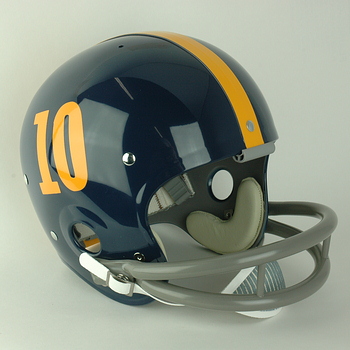

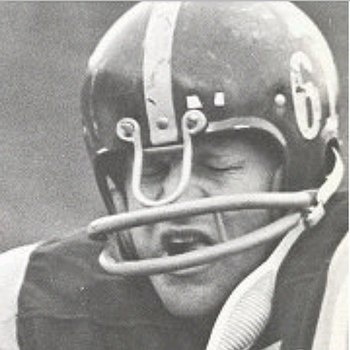
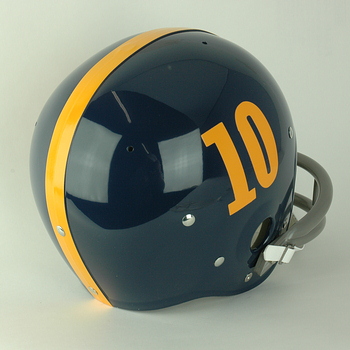
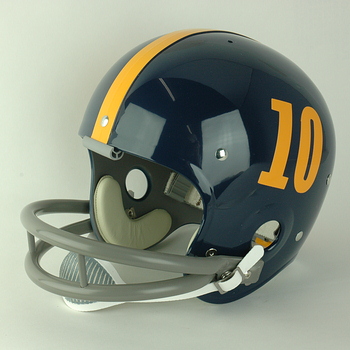
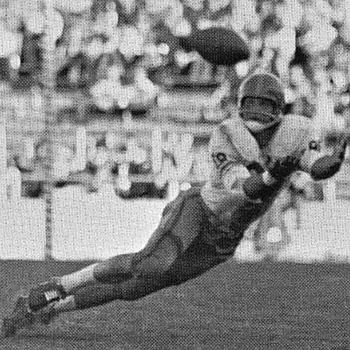
Beginning the 1958 season, Coach Michelosen reversed the 1957 helmet colors and the Jungle Cats were donned in new navy blue helmets with a one-inch Green Bay gold center stripe and three-inch Green Bay gold player identification numerals on each side, Pitt approached what seemed like an annual meat grinder. Athletic Director Admiral Tom Hamilton must have forgotten what it was like to be a head coach as he again set Michelosen up with a horrid schedule that included UCLA, Michigan State, Notre Dame, and Army. The pre-season prognosticators indicated that this Panther team could be excellent yet be lucky to win half of their games and they were correct. The 5-4-1 record, including a 14-all tie versus second ranked Army, came from a crunching rushing attack and hyperactive defensive play by end Mike Ditka, better known for his later work as a tight end. The All American may have utilized his 208-pounds more efficiently on the D-line but the offensive help was there in the form of sophomore fullback Jim Cunningham, '57's leading rusher Fred Riddle, and this season's leading rusher halfback Dick Haley who would have an active five year NFL career playing defensive back and end, halfback, and flanker on the offensive side of the ball for the Redskins, Vikings, and hometown Steelers. He later earned the reputation as one of the most astute personnel men in the pro ranks, being credited with choosing the Steelers famous 1974 draft class. His son Todd has served as offensive coordinator for a number of NFL teams and is the former head coach of the Kansas City Chiefs. Quarterback Ivan Toncic was backed up by young Ed Sharockman who displayed better defensive instincts despite tearing off a fifty-yard touchdown run against Penn State. John “Bull” Guzik was an All American and Academic All American tackle who played linebacker for the Rams and Oilers and the season’s highlight was the last-second 29-26 victory over Notre Dame.
1959 began with the resignation of AD Tom Hamilton. Enormously respected for a lifetime of achievement, the former Naval officer was credited with almost single-handedly keeping collegiate football alive during World War II with the introduction of his Naval Pre-Flight Program and blueprint for maintaining football with the use of service trainees across the country. In an ongoing power struggle against the continuing intrusion of Chancellor Litchfield, he opted to become the Commissioner of the new Athletic Association Of Western Universities Conference which arose with the break-up of the scandal-ridden Pacific Coast Conference. Under new Athletic Director Frank Carver, the Panthers went 6-4. Pitt was a feared team, better than the record indicated and led by a roughneck group primarily from Western Pennsylvania. The offensive line's personality reflected senior center Serafino Fazio, better known as "Foge", who was named team MVP and returned almost two decades later to lead the team as head coach before embarking on a career as an NFL assistant and coordinator. A group of soph linemen copied Fazio's lead with guard Larry Vignali, Ed Adamchick, and Gary Kaltenbach the standouts. Ditka remained a powerhouse on both sides of the ball but was a holy terror on defense and his force of will and the physical intimidation of opponents as well as his own teammates, made everyone play harder and with a greater level of seriousness. After three consecutive mid-season losses, the starting backfield received a facelift. Quarterback Tonic was teamed with "The C Boys", a phrase coined by Pitt’s famed Sports Information Director Beano Cook. Also known as “Catastrophe, Calamity, and Chaos”, fullback Jim Cunningham, and halfbacks Bob Clemens and Fred Cox who also handled the place kicking, took over the offense and proved to be physical and effective. The Sports Illustrated 1960 College Football issue stated it best how the trio salvaged the season: “In the University of Pittsburgh's backfield this fall there are two thick-muscled halfbacks and a squat, pugnacious fullback. Last year, for two thirds of the season, they rested quietly on the bench, partly because of injuries but largely because their inexperience disqualified them under Coach John Michelosen’s adults-only policy. Finally, in a desperate attempt to shore up his sagging team Michelosen played the three together against Boston College. They ran over Boston College, ran over Notre Dame the following week and ran over Penn State the week after that. Their names are Cox, Clemens and Cunningham, and they are known at Pitt as the ‘C boys.’”
1960 proved to be a statistically improbable season. The usually brutal schedule resulted in three ties, with the games against Michigan State, TCU, and Army all finishing at 7-7. The overall 4-3-3 record reflected the level of competition the Panthers faced annually and what was lost to some observers was that the Panthers defeated number-two ranked Syracuse and their great back Ernie Davis 10-0 while the losses to UCLA and Oklahoma were only by a point in each game. For the season the tough defense gave up but seventy-seven points. An injury to lineman Larry Vignali dampened play. Sharockman who filled in admirably at quarterback when necessary, was a heat-seeking-missile as a tackler and had a productive thirteen-year career at defensive back for the Vikings. Ditka continued his All American play as a two-way terror, recognized as a can't-miss pro prospect and tackle Kaltenbach improved playing next to him. The "C Boys" again were an effective one-two-three rushing punch with Jim Cunningham going off to play fullback for the Redskins in a brief three-year career that he extended as one of the better minor league backs, playing with the Continental League Wheeling and Ohio Valley Ironmen until 1969. Quarterback fell to Jim Traficant but the staff was carefully noting the progress of the leader of the undefeated frosh team, Paul Martha.
SPOTLIGHT ON MIKE DITKA:
Most famous as the Pro Football Hall Of Fame tight end of the Chicago Bears who literally stomped opponents as he tore downfield with short passes, Mike Ditka may have been a more accomplished defensive player at Pitt, stuffing sweeps that came in his direction and constantly pressuring the passer. A stout 6'2" 208-pound mass of muscle nicknamed “The Hammer,” the Aliquippa, PA product reflected the flinty nature of the young men who came out of the coal mines and mills of Western Pennsylvania to play college football at Pitt. He was tough catching the ball and began his career with eighteen receptions as a sophomore and then added sixteen as a junior. He was fearsome once he had a head of steam with the ball under his arm, making each run a personal challenge. Pitt’s renowned Sports Information Director Carroll “Beano” Cook observed that “He had a furnace, not a fire, burning inside of him” and this level of motivation and dedication was obvious in every contest and earned entry to the College Football Hall Of Fame. Serving as the Panthers' captain his senior season, he totaled another eleven receptions and was the team's leading receiver. Many don't know that "Iron Mike" was also the team's punter, an accomplished athlete whose fiery personality made him the natural team leader. He carried his ability and passion to both the basketball court and to the outfield while lettering for the Panthers, an accomplished three-sport athlete. Ditka was a unanimous All American and in addition to being named to both The College Football Hall Of Fame and to Pitt's All Time Team, he is still included on many “All Time” and “Best Of…” teams for college football. As a Chicago Bear, his crunching runs toward the goal line defined the modern tight end and remain standards for NFL television programming to this day. His Pro Football Hall Of Fame career which made him the first tight end ever to be inducted, was played primarily with the Bears and later with the Eagles and Cowboys. He returned to the Bears as head coach after learning the coaching craft as a Tom Landry assistant, leading his Monsters Of The Midway to a Super Bowl victory in 1985 and served as the New Orleans Saints head coach from 1997 through ‘99. Ditka's "in your face" style and unfiltered honesty have made him a popular sports commentator and he has become synonymous with the vision of toughness in a football player.
Despite the influx of talented sophomores from an undefeated freshmen team, Michelosen watched the 1961 Panthers suffer a disappointing season at 3-7. After defeating Miami in the opener, they dropped six of the next seven games. The pass defense was particularly poor, giving up thirteen TD's through the air and a total of 209 points, their worst in a decade. The student section often punctuated their displeasure with “cheers” stating “Take a hike, Mike” to the discomfiture of their head coach. Jim Traficant began the season at quarterback but shared time with "super-soph" Paul Martha. Another of the outstanding sophomores was fullback Rick Leeson. Heavily recruited as the Outstanding Back in the High School All American game played in Hershey, PA, he opted to follow in his father Al’s footsteps, a Panthers letterman in the ‘30’s, and was Pitt's leading rusher with 452 yards. Sophomore end Bob Long played both ways with Ed Adamchick next to him at tackle. The three-year run of “The C Boys” reached an end with Bob Clemens catching on briefly with the Colts and Fred Cox not running with the ball but instead kicking it for the Vikings until the end of the 1977 season. He remains their career record holder for most points with his 1365 and most field goals with 282. Cox became a highly-respected chiropractor and was extremely successful in business as the inventor of the Nerf Football. In Paul Martha, Michelosen had an athlete who could do anything on the field and do it well. For the ’62 season, Martha was moved to halfback on offense, played great ball at defensive back, returned kickoffs and punts and was generally all over the field. Fullback Leeson remained the dependable inside runner while senior Lou Slaby proved to be an excellent tackler, earning him a draft spot from the NY Giants where he played middle linebacker. He finished his football career with the Lions and went on to a successful career as a civil engineer. Sophomore end Fred Mazurek at 5'11" and 195 pounds, was another all-around athlete and teamed well with the other end, Bob Long. The line was bolstered by tackles Adamchick and Ernie Borghetti, and an active center who seemed better placed at linebacker, Martin Schoettenheimer. The best this group could muster was a 5-5 finish.
In a surprising 1963 season, the Panthers turned in their best performance since 1937, losing only 24-12 to a Roger Staubach-led Navy team. Admonished by school Chancellor Edward Lichtfield to “show imagination and open up the offense” in an attempt to increase attendance, their 9-1 record against one of the nation's roughest schedules was truly magnificent. Fred Mazurek was moved from end to quarterback and set a number of Pitt records, including 1595 total yards in a season. Against Syracuse he rushed for 119 yards and two touchdowns, passed for 136 and one TD and a two point conversion while leading the squad in rushing and passing. He had the comfort of knowing that he had Kenny Lucas, brother of former Penn State All American and Buffalo Bills QB Ritchie Lucas as his backup. Teaming with talented Martha who was just as effective defensively and on special teams, Pitt did in fact open up the attack to utilize the speed of halfback/receiver Eric Crabtree. Fullback Leeson provided the power and both Martha and tackle Borghetti were named as All Americans. Borghetti was injured in camp with the Chiefs and moved on to his life’s work as a successful dentist. The team was scrappy, very much reflecting the personality of end and co-Captain Al Grugaliunas who had spent part of his childhood in a Communist Displaced Persons Camp. Adamchick moved from tackle to guard and played with the Giants in ’65. Somehow the bowl selectors snubbed Pitt, in part because of the two week delay after President Kennedy’s assassination, before the Panthers could conclude their season against Penn State. Few believed that Pitt’s successful run would include a victory in the finale against the Nittany Lions and when the Panthers won 22-21, many of the bowl selections were already made. There was also a feeling among some that the team, despite their 9-1 record and UPI number three ranking in the nation, did not receive a bowl bid as a reflection of the disrespect held nationally for Eastern football. The team however, proved to be one made up of talented and intelligent individuals. Of the seventy-five who were rostered, sixty-six graduated; thirty-three received advanced or post-graduate degrees including three medical doctors, fifteen dentists, five attorneys, seven educators, and two ministers. Twenty-eight became corporate officers or business owners and quarterback Mazurek married the coach's daughter, Sue Michelosen!
SPOTLIGHT ON PAUL MARTHA:
The 1960 Pitt team was loaded and Coach John Michelosen knew the fans were disappointed in their unlikely and underachieving 4-3-3 record. 1961 held promise with Pitt's undefeated freshman team becoming eligible, led by their quarterback Paul Martha. Martha, out of small Redstone Township High School and Shady Side Academy, would share time with incumbent Jim Traficant but his talent was obvious. As he received more playing time, it was agreed that this 6', 180-pounder was the Panthers' most effective player. He returned kickoffs and punts, he caught, he threw, and he was an elusive yet powerful runner. Most of all, he was a leader with a high degree of intelligence that his teammates responded to. An All America two-way back in 1963, Martha was the Steelers first round pick in 1964 giving him a chance to play at home. Six years with the Steelers and a final one with the Broncos, doing all of the things he did at Pitt on both sides of the ball and on special teams, gave fans a lot of thrilling moments as Martha proved to be a dependable as well as a most versatile player. Martha continued his work in football and athletics as a highly respected attorney who helped to negotiate the settlement of the 1982 NFL players' strike, as general counsel and Vice President of the San Francisco Forty-Niners, as President of the USFL Pittsburgh Maulers and hockey's Pittsburgh Penguins, and continues doing legal work and corporate development related to the NFL. Martha remains one of Pitt's all time greats.
After the attention-grabbing season of '63, expectations were high for 1964 and the 3-5-2 letdown was not well received despite concessions to a horribly difficult schedule. Center Fred Hoaglin was a star and linebacker Marty Schoettenheimer sparked the defense before going off to a solid six-year pro career at linebacker for the Bills and Patriots, and of course, a stellar NFL head coaching career. With future Redskins receiver Fred Mazurek returning at quarterback and Kenny Lucas behind him, the attack was further varied to take advantage of the speed of wide receiver Eric Crabtree who took over the kick and punt return chores for the departed Paul Martha. Barry McNight led the rushing attack from fullback but the line was sub-par and offensive play inconsistent.
SPOTLIGHT ON FRED MAZUREK:
One of the most overlooked football players of the later Michelosen years was Fred Mazurek, yet he was indispensable to any success the Jungle Cats had in the 1962 through ’64 seasons. More importantly, during a period of time before the southern states like Florida had the population volume to be an important recruiting area for college programs, and with Western Pennsylvania, Ohio, and Texas being granted the status of “the best high school football areas” in the nation, Mazurek represented the type of player that John Michelosen recruited for the University Of Pittsburgh. Like teammate Paul Martha, Mazurek hailed from tiny Redstone Township High School in the coal mining town of Republic, Pennsylvania. A child prodigy who many believed could have been a concert pianist, he is still considered by many of his era to be the greatest athlete to come out of the Western Pennsylvania Monongahela Valley region. As was typical of the young men from the mills and mines region of Western Pennsylvania Mazurek came from a family of coal miners and athletes and proved his toughness and team loyalty as early as tenth grade. He suffered a concussion with a subsequent blood clot in his brain during the final game of his sophomore season of high school football, almost died on the operating table during a five hour surgical procedure, and drifted in and out of consciousness for twelve days. Less than thirty days later, he was representing his high school on the basketball court while wearing a modified baseball batting helmet. He was a straight A student, senior class president and as a four year starter as his high school’s quarterback who ran, passed, kicked off, punted, served as the extra point and field goal kicker, returned kickoffs and punts, and was his team’s best defensive player, earned All State and numerous High School All American awards. He even out pointed Joe Namath as the state’s outstanding high school football player. At Pitt, his ability allowed the coaches to utilize him at a number of positions where needed until he settled in as a record setting quarterback who Michelosen believed, “was the best quarterback in America.” As Pitt’s centerfielder he was a .400 hitter and was drafted by the Minnesota Twins and later considered offers from the hometown Pirates. Despite being limited by injury in his senior season, his Pitt career brought the Panthers back to national respectability. More impressive than his athletic career were his many academic accomplishments. Mazurek earned a BS degree in Psychology from Pitt, a MA in Guidance and Counseling from Catholic University, his Juris Doctor (law) Degree, graduating cum laude from Michigan State, and another Masters Degree in Law and Taxation from Wayne State University. Many of the NFL teams backed off of him, believing he would play baseball, and many baseball organizations backed off believing he would pursue a career based upon his academic accomplishments. He signed with the Washington Redskins as a free agent, playing with them as a wide receiver in 1965 and ’66. In 1991, despite being less known among other Pitt football greats, Fred Mazurek was named the University of Pittsburgh Awardee of Distinction. He noted that “We had a quality program in the early 1960’s and we were student-athletes who went on to become successful in the professional world. Look how many became doctors and dentists and lawyers and engineers and teachers and businessmen. When you see what people have accomplished, it gives you a sense of pride, and is indicative of the character and the quality of the coaches at Pitt during this time.”
The sinking ship of Pitt football sprung another leak in the form of a 3-7 finish for the 1965 season, and a lack of depth forced many to play both ways. Against the typical crunching Pitt schedule, this was the kiss of death. Halfback/defensive back Eric Crabtree, fullback/linebacker Jim Flanigan and center/linebacker Tom Metrakos were among those who had to carry the two-way burden. This was a valuable education for Crabtree who played productively for the Broncos, Bengals, and Patriots from ’66 through 1971 and saw action as both a receiver and defensive performer. Quarterback Kenny Lucas guided a team limited in weapons and usually worn out by the fourth quarter in every game. Lucas threw for a new Pitt record of 1921 yards, primarily because they were forced to come from behind in most games. His main target was end Bob Longo. Center Fred Hoaglin had a very productive pro career, primarily with the Browns and later served as an NFL assistant coach for many years. The two defensive ends on the overburdened unit were Ed Assid and Phil Dahar and out of deference to their spirited team captain, the defense labeled themselves “The Rahads” which was Dahar spelled backwards. This was an attempt to emulate the “Chinese Bandits” of LSU fame but the use of too many fatigued two-way players left them with what one writer called “a Chinese puzzle instead of the Chinese Bandits.” As was typical of the true student-athletes that Pitt sought and nurtured, both Dahar and Assid became orthodontists. Michelosen's attempts to add more razzle-dazzle to his decades-long belief in fundamental blocking, tackling, and running football wasn't enough to maintain consistently winning teams and at the end of the '65 season, he departed with a 56-49-7 record and the knowledge he had provided stability to the Pitt program. His players had a high regard for their mentor and many expressed an appreciation that the entire staff throughout Michelosen’s stint encouraged them to study and gave them ample time to excel in their academic work.
If interested in any of these Pittsburgh helmets please click on the photos below.